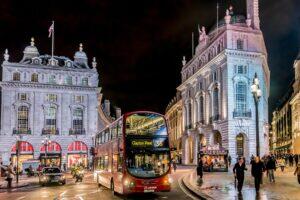Fodor's Expert Review Trafalgar Square
This is officially the center of London: a plaque on the corner of the Strand and Charing Cross Road marks the spot from which distances on U.K. signposts are measured. (London's actual geographic center is a rather dull bench on the Victoria Embankment.) Medieval kings once kept their aviaries of hawks and falcons here; today the humbler gray pigeons flock en masse to the open spaces around the ornate fountains (feeding them is banned).
The square was designed in 1830 by John Nash, who envisaged a new public space with striking views of the Thames, the Houses of Parliament, and Buckingham Palace. Of those, only Parliament is still clearly visible from the square, but it remains an important spot for open-air concerts, political demonstrations, and national celebrations, such as New Year's Eve. Dominating the square is 168-foot Nelson's Column, erected as a monument to the great admiral in 1843. Note that the lampposts on the south side, heading down Whitehall, are topped... READ MORE
This is officially the center of London: a plaque on the corner of the Strand and Charing Cross Road marks the spot from which distances on U.K. signposts are measured. (London's actual geographic center is a rather dull bench on the Victoria Embankment.) Medieval kings once kept their aviaries of hawks and falcons here; today the humbler gray pigeons flock en masse to the open spaces around the ornate fountains (feeding them is banned).
The square was designed in 1830 by John Nash, who envisaged a new public space with striking views of the Thames, the Houses of Parliament, and Buckingham Palace. Of those, only Parliament is still clearly visible from the square, but it remains an important spot for open-air concerts, political demonstrations, and national celebrations, such as New Year's Eve. Dominating the square is 168-foot Nelson's Column, erected as a monument to the great admiral in 1843. Note that the lampposts on the south side, heading down Whitehall, are topped with ships—they all face Portsmouth, home of the British navy. The column is flanked on either side by enormous bronze lions. Climbing them is a very popular photo op, but be extremely careful, as there are no guardrails and it's a long fall onto concrete if you slip. Four plinths border the square; three contain militaristic statues, but one was left empty—it's now used for contemporary art installations, often with a wry and controversial edge. Surprisingly enough, given that this was a square built to honor British military victories, the lawn at the north side, by the National Gallery, contains a statue of George Washington—a gift from the state of Virginia in 1921.
At the southern point of the square is the equestrian statue of Charles I. After the Civil War and the king's execution, Oliver Cromwell, the antiroyalist leader, commissioned a brazier, John Rivett, to melt the statue down. The story goes that Rivett instead merely buried it in his garden. He made a fortune peddling knickknacks wrought, he claimed, from its metal, only to produce the statue miraculously unscathed after the restoration of the monarchy—and then made another fortune reselling it. In 1675 Charles II had it placed where it stands today, near the spot where his father was executed in 1649. Each year, on January 30, the day of the king's death, the Royal Stuart Society lays a wreath at the foot of the statue.
READ LESS








